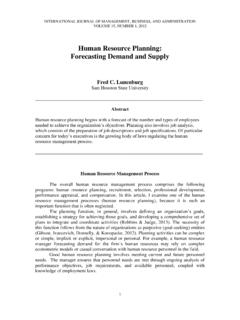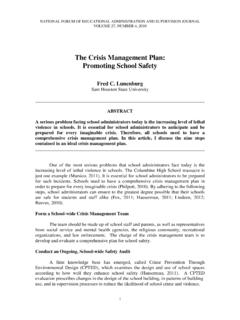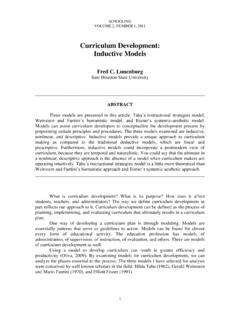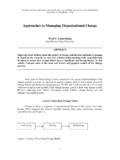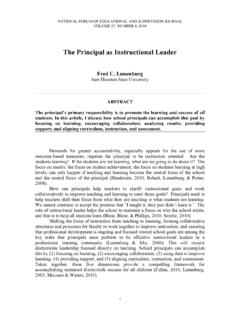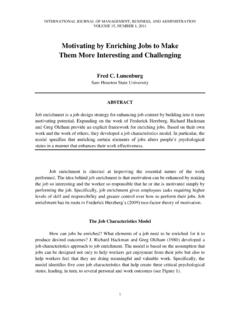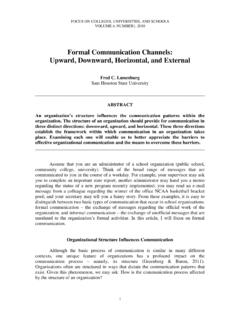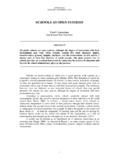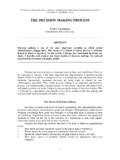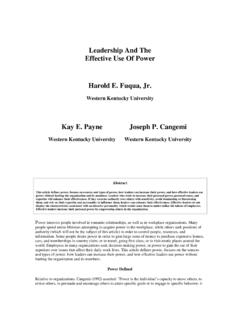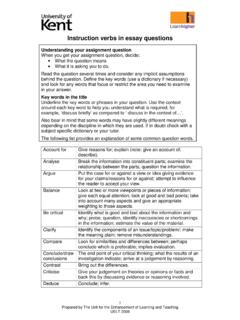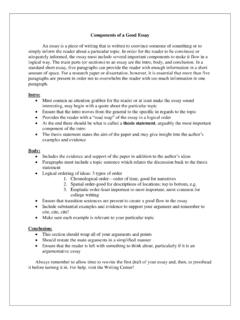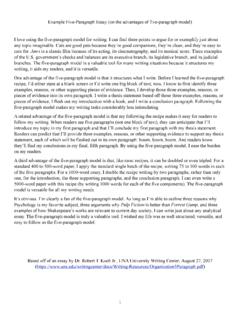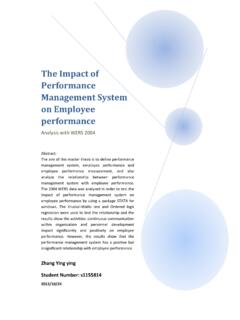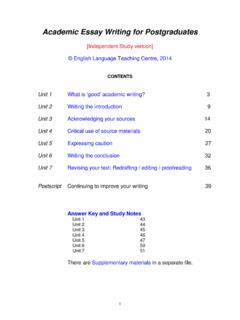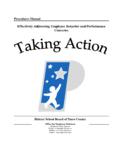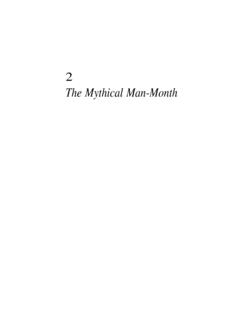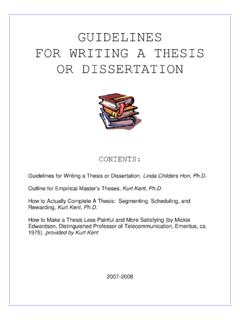Transcription of Key Components of a Curriculum Plan: Objectives, Content ...
1 SCHOOLING VOLUME 2, NUMBER 1, 2011 1 Key Components of a Curriculum Plan: Objectives, Content , and Learning Experiences Fred C. Lunenburg Sam Houston State University _____ ABSTRACT There are a number of fundamental questions that help determine the development and implementation of a plan for instruction. Regardless of definition or approach, Curriculum can be organized into three major Components : objectives, Content or subject matter, and learning experiences. Think of objectives as a road map ( where are we going), Content as the what of Curriculum , and learning experiences as the how. The interrelationship of each of these Components is examined using Tyler s classic Curriculum model.
2 _____ Curriculum developers must always be concerned about what should be included in the Curriculum and how to present and arrange what is selected. In other words, they must first deal with Content or subject matter and then learning experiences. These tasks are preceded by formulating behavioral objectives, which act as a road map for the Curriculum development and implementation process. Regardless of the Curriculum approach or development model used, Curriculum leaders cannot ignore these three Components . Committees charged with Curriculum planning have options in selection of Content and experiences to be determined in part by the philosophical and psychological views of the committee members, the school, and the school district.
3 Unquestionably, there is much Content and a variety of learning experiences to include. Committee members must decide not only what Content and learning experiences to include, but also, and more importantly, the relationship of objectives and Content as well as the relationship of objectives to learning experiences. Relationship of Objectives and Content Objectives are usually stated in terms of expected outcomes. For example, a high school science teacher might develop a chronological list of topics to be covered in a high school biological science course: functions of human organisms, use of plant and animal resources, evolution and development, and the like (Williams, 2011).
4 This type of list SCHOOLING 2_____ shows what the science teacher intends to teach but not what the expected outcomes of instruction will be. The Content outline is useful for the teacher in planning and guiding instruction, but it is insufficient for the statement of behavioral objectives. To be useful in teaching, behavioral objectives must be linked to Content . The real contribution of stating objectives for learning is to think of how each objective can be achieved by students through the Content or subject matter they learn. Ralph Tyler (1949) in his now classic text, Basic Principles of Curriculum and Instruction, has devised a two-dimensional chart for specifying varied types of objectives according to the subject-matter Content and the behavioral aspects of the objectives (see Table 1).
5 Table 1 Two-Dimensional Chart for Stating Objectives for a High School Course in Biological Science Behavioral Aspects of the Objectives Content Aspects of the Objectives of important facts and principles with dependable sources of information 3. Ability to interpret 4. Ability to apply principles 5. Ability to study and report results of a study 6. Broad and mature interests 7. Social attitudes A. Functions of human organisms 1. Nutrition X X X X X X X 2. Digestion X X X X X 3. Circulation X X X X X 4. Respiration X X X X X 5. Reproduction X X X X X X X B. Use of plant and animal resources 1. Energy relationships X X X X X X 2. Environmental factors conditioning plant and animal growth X X X X X X X 3.
6 Heredity and genetics X X X X X X X 4. Land utilization X X X X X X X C. Evolution and development X X X X X X X As shown in Table 1, seven types of behavior are aimed at in the biological science course. The first type of behavior is to develop understanding of important facts and principles; the second type is to develop familiarity with dependable sources of information; the third type of behavior is to develop the ability to interpret data; the fourth type is to develop ability to apply principles that are taught in biological science to concrete biological problems in life; the fifth type of behavior is to develop the ability to study and report the results of an investigation; the sixth type is to develop broad and mature interests as they relate to biological science, and the seventh type of behavior is to develop social attitudes.
7 FRED C. LUNENBURG _____3 However, the listing of behavioral aspects is not a sufficient formulation of objectives to be most useful in teaching. Hence, Table 1 also includes a statement of the Content aspects of the objectives. Note that the course is viewed as developing these seven behaviors in relation to the nutrition of human organisms, digestion, circulation, respiration, and reproduction. Moreover, note that the course deals with the use of plant and animal resources including energy relationships, environmental factors conditioning plant and animal growth, heredity and genetics, and land utilization. Finally, note that the behavioral objectives relate to evolution and development.
8 The formulation of the Content aspects of the objectives have served still further to clarify the job to be done by the biological science course. Furthermore, the table indicates the relationship of the two aspects of the objectives: behavioral and Content . The intersections of the behavioral columns and the Content rows are marked with X s when it is implied that the behavioral aspect applies to a particular area of Content . Relationship of Objectives to Learning Experiences In his classic text on Curriculum , Tyler defined the term learning experiences as follows: The term learning experience is not the same as the Content with which a course deals nor the activities performed by the teacher.
9 The term learning experience refers to the interaction between the learner and the external conditions in the environment to which he/she can react. Learning takes place through the active behavior of the student. (p. 63) Tyler argues that the teacher s problem is to select learning experiences that will foster active involvement in the learning process in order to accomplish the expected learning outcomes. Tyler outlined five general principles in selecting learning experiences: 1. The learning experience must give students the opportunity to practice the desired behavior. If the objective is to develop problem-solving skills, the students should have ample opportunity to solve problems.
10 2. The learning experience must give the students satisfaction. Students need satisfying experiences to develop and maintain interest in learning; unsatisfying experiences hinder their learning. 3. The learning experience must fit the students needs and abilities. This infers that the teacher must begin where the student is ability-wise and that prior knowledge is the starting point for new knowledge. 4. Multiple learning experiences can achieve the same objective. There are many ways of learning the same thing. A wide range of experiences is more effective for learning than a limited range. 5. The learning experience should accomplish several learning outcomes.
